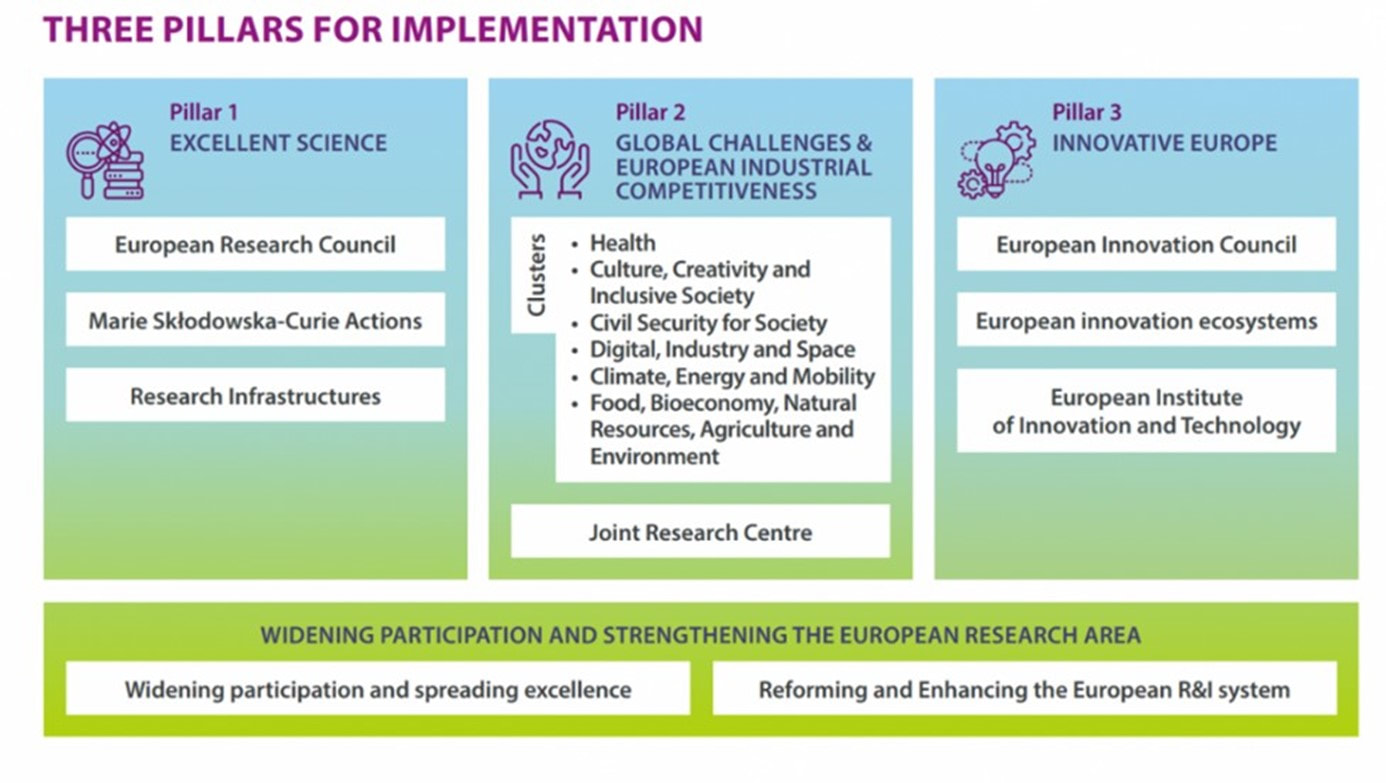News |
|
Horizon Europe, the long-awaited successor to Horizon 2020, and the world’s largest transnational research and innovation programme, is finally ready to take off! The programme is designed to support European competitiveness by creating new growth and jobs based on scientific knowledge and technological development, all the while tackling societal challenges and helping to sustain European socio-economic models and values. So, how does it work concretely? The programme has been built on three main Pillars, each of them having a different objective:
Pillar II “Global Challenges and European Industrial Competitiveness” has a budget of EUR 53.5 billion (out of EUR 95.5 billion) for 2021-2027, Pillar 2 holds the lion’s share of the programme funding.
Pillar II supports research projects carried out (mostly) by international and inter-disciplinary consortia. The projects address specific pre-defined topics proposed by the EC which fall into six different clusters, each of them foused on specific societal challenges, namely (1) Health, (2) Culture Creativity and Inclusive Society, (3) Civil Security for Society, (4) Digital Industry & Space, Climate, (5) Energy & Mobility, and (6) Food, Bioeconomy, Natural Resources, Agriculture & Environment. Calls for these projects consist of very specific topics – each topic defines a research or innovation challenge to be addressed by the project, including scope and expected outcomes in a “top-down” approach. The type of project, budget, deadline and evaluation procedure are also specified for each topic. The projects are carried out by international consortia that bring together not just research organisations, but also private companies, public authorities, non-governmental organisations and others – all actors that are needed to tackle the (often complex) topic. The participation of potential users of project results (companies, hospitals, public authorities, civil society, farmers, etc. – depending on the topic) is especially important. All the calls will be written into a document called ‘work programme.’ Each cluster publishes its own work programme on a biannual basis; for example, the calls for 2021-2022 were published in June 2021. The best way to find calls for proposals is to visit the European Commission’s official page, the EC Funding and Tenders Portal. It helps to already have a pretty good idea what you are looking for when you connect to the portal, as over 1800 calls have been published for the next 2 years! There are a number of different types of “actions” under Pillar 2, each with their own specificities. The three main types of actions are:
The theoretical minimal requirement in RIA and IA is the participation of at least 3 legal entities from 3 different countries (EU member states or countries associated to Horizon Europe). However, in practice, successful consortia usually consist of 8 – 20 or even more partners (depending on the scope and overall funding of the topic). CSA can be theoretically carried out by a single legal entity, however in practice, these projects are usually also carried out by large consortia as the scope can be quite wide. What about European Partnerships? In addition, Horizon Europe plans to simplify the landscape of various initiatives launched in Horizon 2020 and previous research framework programmes (Joint Programming Initiatives, Joint Technological Initiatives, Flagships, Public to Public Partnerships, ERA-Nets, etc). The European Partnerships will bring together the European Commission on one side and on the other side private stakeholders (e.g. international associations of businesses in certain sectors) and/or public (e.g. member state ministries, national funders) interested in a certain topic/field to avoid the duplication of investments and coordinate strategic planning – the partnerships sometimes launch their own calls for research proposals and sometimes influence topics to be funded by Horizon Europe. There will be 3 types of European Partnerships:
Finally, European research and innovation missions aim to deliver solutions to some of the greatest challenges facing our world. In order to more effectively address selected societal challenges, the European Commission has adopted a mission-oriented approach to drive part of the next Horizon Europe Framework Programme. While acknowledging the added value of the Framework Programme for supporting European research, numerous past studies and evaluations have called for stronger strategic orientation and better coordination of the various funded activities. Adding a mission component within Horizon Europe is an unprecedented attempt to respond to this imperative. Missions represent one of the main novelties of Horizon Europe, in the form of high-ambition, high-profile portfolios of projects and initiatives which will put forward concrete solutions to challenges facing European citizens and society. To date, five mission areas have been defined.
In conclusion, there is something for everyone within Pillar 2 of the Horizon Europe framework programme! Over the next 7 years, this 9th Framework Programme will bring together Europe’s leading research organisations, academic institutions, private companies, public authorities, and NGOs to respond to the world’s most pressing research questions. While it can sometimes seem tricky to identify the right opportunities for your project, build your consortium and develop a successful proposal, consultants can help you navigate throughout the whole process. As a matter of fact, many structures - public and private – offer a complementary range of services adapted to your needs in the different phases of preparation and definition of a project's set-up and submission. Identifying and mobilising the right support structure at the right time is one of the key success factors for successful access to European funding programmes. To find consultancy companies with expertise in the field of European-funded projects and whose professionalism is duly recognised, please consult the list of EAIC’s members. Article courtesy of EAIC member, FI Group.
3 Comments
23/8/2022 13:05:17
I've read your article on its whole. I think your work is excellent, and I wish you the best of luck. Keep working in this manner.
Reply
Leave a Reply. |
Categories
All
Archives
July 2024
|



 RSS Feed
RSS Feed
